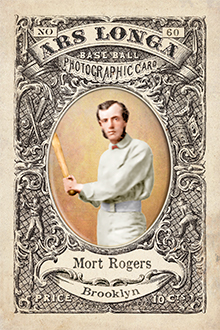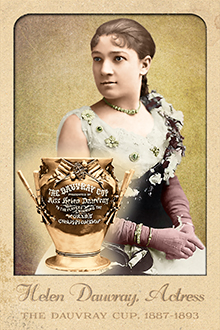
- Series: Pioneer Portraits I: 1850-1874
- City: New York
- Team: Knickerbockers
Daniel Lucius Adams (1814-1899) was playing baseball before the game was well organized or codified. He and other young doctors in New York simply found the game a great outdoor exercise. He was part of the New York Base Ball Club by 1840, five years before joining the Knickerbockers, considered by many to be the developers of the game we know today. Whatever he called it, Doc would go on to write the book on the national pastime, literally. Adams was a perennial leader among the founding fathers of the day. He advocated or arbitrated the evolving rules that came to shape the game: nine players, nine innings, ninety feet between the bases (forever to be the gold standard of human perfection). Historian John Thorn has decreed Doc as “first among the Fathers of Baseball.” The list of credentials supporting that title are too numerous to detail here. The origins of the American Game have always been curiously shrouded. The luminaries who invented the game were largely anonymous for decades. Once the Abner Doubleday myth was finally punctured, it has remained for modern historians to fill the gaps and Doc Adams has rightly assumed a prominent place in the pantheon.
- Credited with creating the shortstop position, first as a relay man when the flimsy balls made outfield throws difficult, then as a key spot in the infield defense
- In 2016, Adams' 1857 “Laws of Baseball” brought the phenomenal sum of $3.26 million at auction amid a trove of documents from that era
- Doc Adams was SABR’s Overlooked 19th Century Baseball Legend for 2014
- Doc Adams’ candidacy for election to the National Baseball Hall of Fame was finally put to vote when he appeared on the Pre-Integration Era Committee Ballot for 2016. Needing 12 of the 16 committee members’ votes for election, Doc unfortunately fell two votes short.

- Series: Pioneer Portraits I: 1850-1874
- City: Brooklyn
- Team: Resolute BBC
- League: National Association (NABBP)
Maxson Mortimer Rogers (1845-1881) had a profound impact on both the national pastime and the innovation of the baseball card. Unfortunately, his unique contributions have been largely lost to memory and obscured by history.
Rogers began his sporting life as a cricketer and, by the mid 1860s, had become a prominent star baseball player and executive for Civil War era teams such as the Resolute BBC of Brooklyn. By 1864, Rogers was secretary of the NABBP, baseball’s first professional league, and was elected the league’s first vice-president in 1867.
As a professional printer and entrepreneur, Rogers self-published a weekly sports paper called the New England Chronicle from 1869-1870, devoting substantial ink to the developing game he loved.
By 1871, Rogers was umpiring NABBP games in Boston while self-printing and selling “Base Ball Photographic Cards” at the games for .10 cents a piece (the price was later dropped to .05 cents). Rogers’ stated ambition was to produce a card for every prominent player in the country, but as so few of his cards exist today it is difficult to know the exact diversity or quantity of cards he was able to produce.
The Mort Rogers’ Scorecards were foldable scorecards with an image of a baseball player on the front pane (including the player’s name, position and team), a scorecard in the center two panes for that day’s game, and a group of advertisements on the rear pane. Rogers produced and sold the cards from 1871-1872.
Although there is still great debate over which card or set of cards should be considered the very first, a solid case can be made to declare Mort Rogers the Father of the Baseball Card. Ars Longa pays homage to Rogers’ legacy with this very Pioneer Portraits I series of art cards.
- A testament to his playing prowess is Mort’s inclusion in an 1865 woodcut in Frank Leslie’s Illustrated Newspaper depicting the “leading players” among NYC clubs (The woodcut includes a black-shrouded Jim Creighton in memoriam and an unidentified non-player thought to be Henry Chadwick)
- Mort’s younger brother Fraley Rogers was an early star in NY and Boston, but had an ill-starred fate as the first pro player to take his own life, at age 30, three days before Mort’s death
- Historian John Thorn, who has done groundbreaking work on contenders for “earliest baseball cards,” honors and cites Rogers’ work as the “first numbered set”
- In Mort’s honor, his Ars Longa card is numbered 60, the last in the set. The complete set will be numbered 1-58 & 60 with number 59 omitted from the series to represent the original Mort Rogers' Scorecards that are likely lost to us.

- Series: Pioneer Portraits II: 1875-1899
- League: National League
Ida Louisa Gibson (1856-1923), aka Helen Dauvray, was a child prodigy on the stage whose subsequent real estate investments made her wealthy. By 1887 her acting career was waning, but she had grown accustomed to and still longed for the acclaim accorded theatrical stars of her era. A love affair with celebrated baseball hero John Montgomery Ward was budding when Helen announced she would commission a "$500 . . . true lover's cup" to be presented annually to the players who triumphed in the “World's Championship” between the American Association and National League. In an era of shameless self-promotion, Helen's award gained traction in baseball and cast her back into the spotlight. It endured precisely as long as the romance between Monty Ward and the woman still known by many as Little Nell, the California Diamond after a long-running role of Helen's.
The Gorham Silver Co. finished the 12" tall cup on June 1, charging Helen $250. It was engraved “THE DAUVRAY CUP, Presented By Miss Helen Dauvray, to the players winning the WORLD'S CHAMPIONSHIP.” It didn't take long for some to realize that the cup would undoubtedly reside in the team owner's office, so Dauvray also commissioned medals to be given to individual players, a few of which survive in the Hall of Fame and private collections today.
Alas, the Dauvray Cup is now lost to history, having served its purpose from 1887-1893. The American Association expired following the 1890 tournament, so Miss Dauvray redirected it to become the trophy for the National League's champions. Helen had proposed that the cup become the permanent property of any club to win it three times consecutively, and the Boston Beaneaters took final possession following their third straight win in the fall of 1893. The cup was known to be in Kentucky that winter but, sadly, has disappeared since. Perhaps fittingly, the end of the cup's reign coincided with the Ward-Dauvray union's demise. Married in '87, the celebrity couple divorced in 1893.
The first recipients of the cup were not, as Dauvray may have expected, Ward's Giants. Rather, the Detroit Wolverines captured it first in a marathon 15-game series that was as much a barnstorming tour as a post-season tourney. The cup toured with the teams that inaugural year and offered Miss Dauvray the attention she sought, being displayed on the field during each game. In 1894, Helen's legacy lived on in the Temple Cup, instituted by Pirates owner William Chase Temple, to honor the winners of the NL's seven-game post-season series. It was awarded four times, last in 1897. Unlike its predecessor, the Temple Cup resides today in Cooperstown.
- Ars Longa is indebted to baseball historian John Thorn for his excellent research on the Dauvray Cup and the delightfully insouciant Miss Dauvray herself

- Series: Pioneer Portraits II: 1875-1899
- City: Boston
Michael “Nuf Ced” McGreevy (1865-1943) was the leader of the Royal Rooters, Boston’s premier baseball and drinking club, based at McGreevy’s Third Base Saloon “1200 steps from Fenway Park.” When arguments of Braves vs. Red Sox (Americans) broke out, he ended the fight by shouting “Nuf Ced!” An ardent crank of the Boston Beaneaters for nearly two decades, McGreevy appears to have pledged his allegiance to the Red Sox for two primary reasons: Jimmy Collins, his favorite Beaneater, jumped to the Boston Americans in 1901, the inaugural season of the American League; and Ban Johnson's new league offered cheaper tickets, enabling McGreevy and his patrons to attend more games. This switch had an enormous impact on the fortunes of professional baseball in Boston, perhaps positing McGreevy as the true Father of Red Sox Nation and foreshadowing the (Beaneaters) Braves' move to Milwaukee 53 years later.
- Opened in 1894, the Third Base Saloon got its name to designate it as “the last stop before home”
- McGreevy was an avid collector who decorated his saloon with wall-to-wall cabinet cards, photographs and game used memorabilia
- In his SABR bio on McGreevy, Peter Nash called the Third Base Saloon, "baseball's first true museum"
- When prohibition forced the closure of his saloon, McGreevy donated his collection to the Boston Public Library
- Series: Pioneer Portraits II: 1875-1899
- Hall: National Baseball Hall of Fame
Henry Chadwick (1824-1908) is widely considered the “Father of Baseball” due to his profound influence on early public awareness of the game and upon its foundational rules. A journalist from Brooklyn, Chadwick was present at the creation as he saw the new game developing in the 1860s and began what would become sports reporting today.
- Literally wrote the book on baseball: Beadle’s Dime Base Ball Player in 1860
- Edited Spalding’s Official Base Ball Guide for decades
- Saw to it we don’t have tie games or one-bounce outfield put-outs today
- Elected to Hall of Fame: 1938




